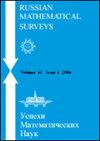螺线管场中的球
IF 2.1
4区 数学
Q1 MATHEMATICS
引用次数: 0
摘要
根据狄拉克的说法,与不做功的附加外力有关的运动方程的变化可以用泊松支架的变形来描述。人们很自然地要问狄拉克的思想在非完整力学中是否有效。这里我们以Chaplygin舞会为例来讨论这个问题。我们考虑李代数e *(3)上的线性Lie - poisson括号:本文章由计算机程序翻译,如有差异,请以英文原文为准。
Chaplygin ball in a solenoidal field
According to Dirac, changes in the equations of motion related to additional external forces performing no work can be described in terms of deformations of the Poisson bracket. It is natural to ask whether or not Dirac’s ideas are valid in non-holonomic mechanics. We discuss this question here by taking the Chaplygin ball as an example. We consider the linear Lie–Poisson bracket on the Lie algebra e∗(3):
求助全文
通过发布文献求助,成功后即可免费获取论文全文。
去求助
来源期刊
CiteScore
1.70
自引率
0.00%
发文量
12
审稿时长
>12 weeks
期刊介绍:
Russian Mathematical Surveys is a high-prestige journal covering a wide area of mathematics. The Russian original is rigorously refereed in Russia and the translations are carefully scrutinised and edited by the London Mathematical Society. The survey articles on current trends in mathematics are generally written by leading experts in the field at the request of the Editorial Board.

 求助内容:
求助内容: 应助结果提醒方式:
应助结果提醒方式:


